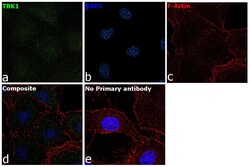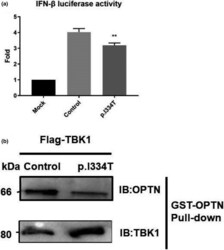Antibody data
- Antibody Data
- Antigen structure
- References [2]
- Comments [0]
- Validations
- Immunocytochemistry [1]
- Other assay [1]
Submit
Validation data
Reference
Comment
Report error
- Product number
- PA5-17478 - Provider product page

- Provider
- Invitrogen Antibodies
- Product name
- TBK1 Polyclonal Antibody
- Antibody type
- Polyclonal
- Antigen
- Synthetic peptide
- Description
- It is not recommended to aliquot this antibody.
- Reactivity
- Human, Mouse, Rat
- Host
- Rabbit
- Isotype
- IgG
- Vial size
- 100 μL
- Concentration
- 174 μg/mL
- Storage
- -20°C
Submitted references Association of the TBK1 mutation p.Ile334Thr with frontotemporal dementia and literature review.
Haploinsufficiency of TBK1 causes familial ALS and fronto-temporal dementia.
Yu H, Yu W, Luo SS, Yang YJ, Liu FT, Zhang Y, Chen Y, Sun YM, Wu JJ
Molecular genetics & genomic medicine 2019 Mar;7(3):e547
Molecular genetics & genomic medicine 2019 Mar;7(3):e547
Haploinsufficiency of TBK1 causes familial ALS and fronto-temporal dementia.
Freischmidt A, Wieland T, Richter B, Ruf W, Schaeffer V, Müller K, Marroquin N, Nordin F, Hübers A, Weydt P, Pinto S, Press R, Millecamps S, Molko N, Bernard E, Desnuelle C, Soriani MH, Dorst J, Graf E, Nordström U, Feiler MS, Putz S, Boeckers TM, Meyer T, Winkler AS, Winkelman J, de Carvalho M, Thal DR, Otto M, Brännström T, Volk AE, Kursula P, Danzer KM, Lichtner P, Dikic I, Meitinger T, Ludolph AC, Strom TM, Andersen PM, Weishaupt JH
Nature neuroscience 2015 May;18(5):631-6
Nature neuroscience 2015 May;18(5):631-6
No comments: Submit comment
Supportive validation
- Submitted by
- Invitrogen Antibodies (provider)
- Main image

- Experimental details
- Immunofluorescence analysis of TBK1 was performed using 70% confluent log phase A549 cells. The cells were fixed with 4% paraformaldehyde for 10 minutes, permeabilized with 0.1% Triton™ X-100 for 15 minutes, and blocked with 2% BSA for 1 hour at room temperature. The cells were labeled with TBK1 Polyclonal Antibody (Product # PA5-17478) at 1:100 dilution in 0.1% BSA, incubated at 4 degree celsius overnight and then labeled with Goat anti-Rabbit IgG (H+L) Superclonal™ Recombinant Secondary Antibody, Alexa Fluor® 488 (Product # PA5-17478) at a dilution of 1:100 for 45 minutes at room temperature (Panel a: green). Nuclei (Panel b: blue) were stained with ProLong™ Diamond Antifade Mountant with DAPI (Product # P36962). F-actin (Panel c: red) was stained with Rhodamine Phalloidin (Product # R415). Panel d represents the merged image showing cytoplasmic localization. Panel e represents control cells with no primary antibody to assess background. The images were captured at 60X magnification.
Supportive validation
- Submitted by
- Invitrogen Antibodies (provider)
- Main image

- Experimental details
- Figure 4 In vitro functional analysis of TBK1 mutation. (a) Luciferase activity in HEK293T cells cotransfected with an IFN-beta reporter plasmid and a GFP-tagged wild-type plasmid or a p.Ile334Thr mutation TBK1 plasmid for 24 hr. Firefly luciferase activity served as an internal control. Values are expressed as mean +- SEM , ** p < 0.05. (b) Interaction between TBK1 and its downstream autophagy receptor optineurin. Lysates of a GFP-tagged wild-type TBK1 or p.Ile334Thr from HEK293T cells were incubated with GST-OPTN. Both cell lysates and bound proteins were detected by western blotting
 Explore
Explore Validate
Validate Learn
Learn Western blot
Western blot Immunocytochemistry
Immunocytochemistry Immunoprecipitation
Immunoprecipitation